Project Log: Monday, May 28, 2012
I spent a good part of the morning preparing orders for
standard materials to replenish some of my electrical
stocks, reviewing installation manuals, and tracking
down various pieces and parts I needed for the steering
system and elsewhere, specifically fittings and
additional hoses for connecting the autopilot hydraulic
pump and steering cylinder, including shutoff valves
(for maintenance purposes) and related fittings.
In order to tie in the autopilot pump, I required tee
fittings in the main steering lines; these I had on
hand, but needed some adapters and other connectors.
This is the Simrad RPU80 autopilot pump, along with a
collection of connectors. |
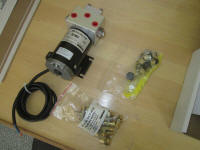 |
Up in the boat afterwards, I started to complete the
steering hose run to the aft compartment. I ran
the two main lines through the bulkhead, and started
securing the hoses along the run. At this point,
however, decided I wasn't happy with the hose route I'd
chosen from the console down through the engine room. I didn't like their proximity to the
diesel heating boiler exhaust outlet, though the
clearance was probably OK, but I was also concerned that
the lines dipped too low at their forward end, creating
an overall downhill orientation from the stern (not
including the height of the helm). The
installation manual suggested that this situation could
make bleeding air from the system more difficult.
In addition, the current route required the hoses to run
across an open part of the engine room, where regular
maintenance to other installations could potentially
cause damage, or at least require extra care to prevent
such damage. |
Original location of steering hoses
from 25 May 2012
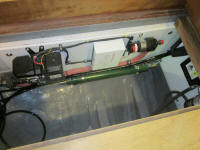 |
After looking things over, it occurred to me (and
perhaps I'd had this thought months ago during my most
tentative planning stages) to run the hoses out the side
of the console and into the space outboard of the port
bulkhead. This would accomplish several desirable
things: provide a cleaner, more logical run for
the hoses inside the console itself; keep the hoses out
of the engine room and away from various heat sources;
provide a constant uphill angle from the stern to the
helm; and keep the hoses clear and out of the way
throughout their entire run aft. As things turned
out, this new route would also give me about a foot or
more of extra slack at the aft end, though this was less
critical than I'd thought a couple days ago.
Not wishing to fight anew the stubborn nylon
compensating line that I'd previously run aft, I decided
to detach the hoses from the helm pump instead.
This gave me my first opportunity to test the "finished"
access to the inside of the helm console. My goal
in systems (and other) installations is to always allow
access with relative ease, if not always perfectly wide
open. Certainly I'd not planned to be
disassembling the helm anytime soon, but nonetheless I
found the access to be satisfactory, and simply unbolted
the helm and pulled it through to the exposed side to
access the hose connections.
After removing the hoses, various clamps, and wire ties,
I pulled the hoses out through the bottom of the console
and led them through a space at the aft end of the port
bulkhead. Inside the console, I drilled 2"
hole through the side in the appropriate place (which
I'd marked after judging by eye the best location based
on the old hose route), and ran the hoses back into the
console through a length of 1-1/2" white hose for chafe
and kinking protection. I resecured the three
lines to the helm pump, and bolted the pump back in
place. |
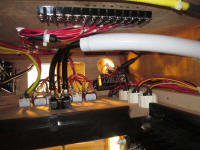
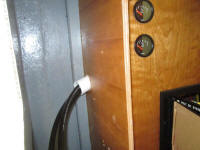
 |
I secured the hoses in a couple places on their route
through the utility space outboard of the port bulkhead,
securing cushioned clamps to a bolt stud beneath the
engine's coolant reservoir and to a section of the
fiberglass bulkhead aft (with the hoses run through
lengths of chafe gear for added protection). |
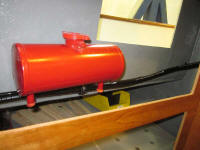
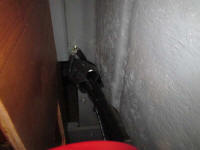 |
Continuing aft, I installed a length of split hose to
protect the steering lines from rubbing against the
bottom of the cockpit, and then through a final length
of hose leading through the bulkhead into the after
steering room. When all was said and done, I had
plenty of extra hose length for the final connections
I'd need to make within this space, though that wouldn't
happen till I got the steering cylinder mounted.
|
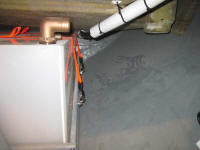
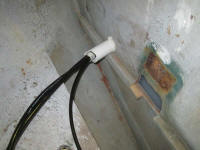
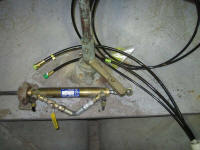 |
This process took quite a long time when all was said
and done. Afterwards, and while I was in the
space, I resecured the collar connecting the two
sections of the rudderpost; then, since it was already
driving me crazy in its looseness, I determined the
location for and installed the microphone holder for the
VHF radio, since the mike was permanently attached to
the radio, as they all are these days (mikes used to be,
years ago, removable; who decided that this was
something that needed to be changed, I wonder, and
why?). |
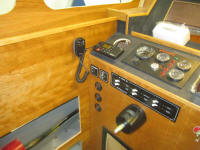 |
| |
Total Time Today: 6.75 hours
|
<
Previous |
Next > |
|
|












